The Secret Seven – Africa’s Elusive Safari Animals
Written by
Ker & Downey® Africa
Some creatures of the African bushveld live extremely private lives, separate from the antics of the familiar faces we have come to know and love. This underground club (quite literally in some cases) is made up of seven enigmatic safari animals who exist secretly in the shadows. Rarely spotted on game drives, but high on avid wildlife aficionados’ checklists, they are mostly nocturnal, solitary and very shy, making a sighting something truly special. Each one of the ‘Secret Seven’ has uniquely adapted to life in the dangerous wilderness, displaying incredible resilience and strategies for survival.
Introducing Africa’s most elusive safari animals…
Are you ready?
Aardvark
The bizarre and bewildering aardvark is an elusive member of the animal kingdom. This strange ‘earth pig’ (the direct translation of its Afrikaans name) resembles a mashup of different creatures. Its stocky body is akin to that of a pig, while its snout can be likened to that of an anteater (with a pig’s snout). It sports a gangly kangaroo-like tail and a rabbit’s long ears, making it a truly unique looking animal. Aardvarks are nocturnal, solitary creatures, emerging from their underground burrows after the sun sets. While their beady little eyes may not see very far, their acute smell and hearing help them to avoid danger whilst foraging for food in the dark. An aardvark’s diet consists of ants and termites, exclusively – a diet that has not changed in 20 million years (the earliest aardvark fossils from Africa are roughly 20 million years old!). With its long agile tongue and sticky saliva, an aardvark can lap up as many as 50,000 ants or termites per day.
Where can I see an aardvark?
Aardvarks are found in almost all of Africa’s national parks and reserves, but are notoriously hard to spot. There are certain regions that are renowned for sightings, particularly semi-arid regions like the Karoo in South Africa, Namibia’s Damaraland or the Makgadikgadi Pans in Botswana.
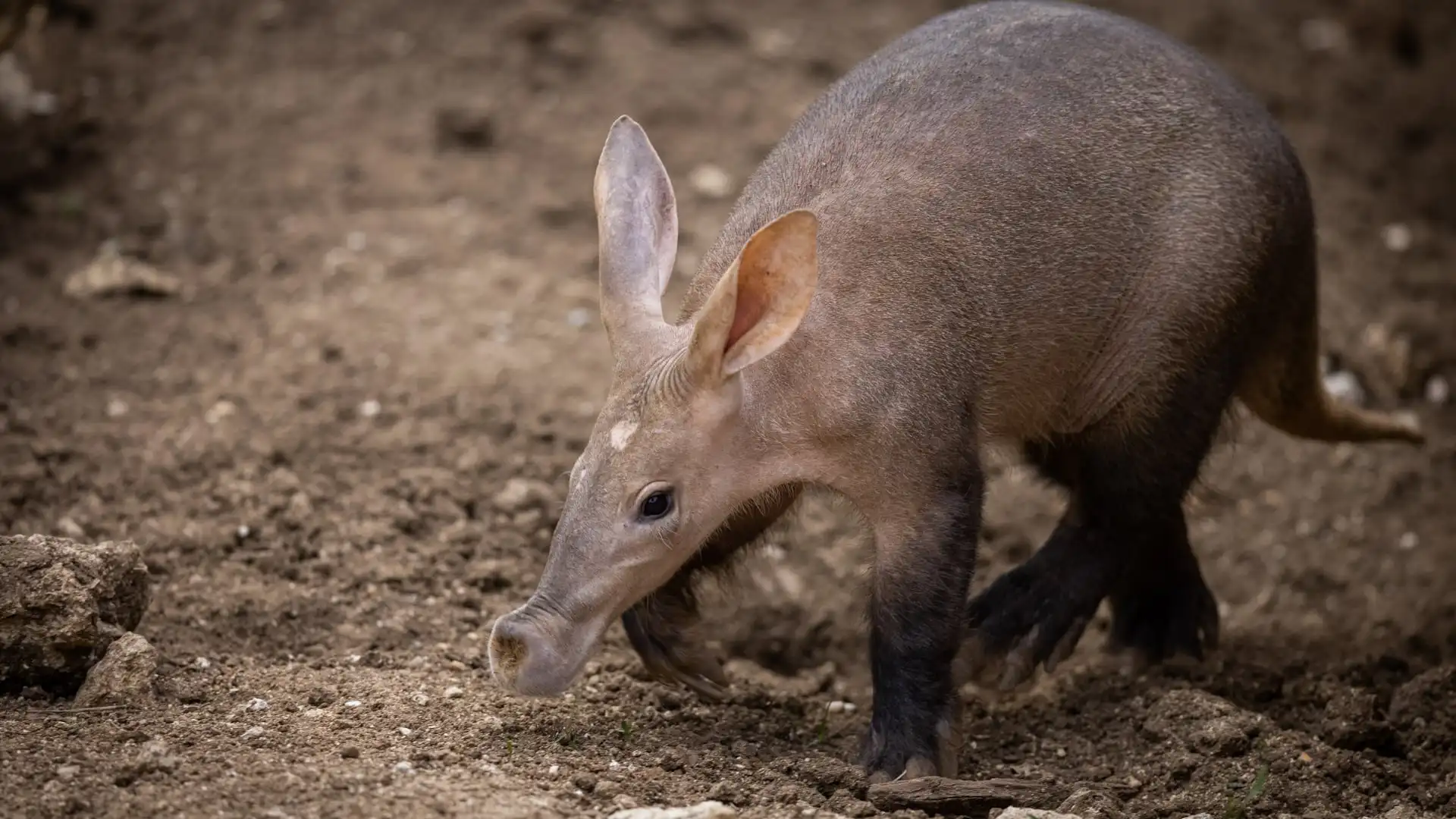
The fascinating and enigmatic aardvark
Pangolin
Arguably the most elusive member of the Secret Seven, the nocturnal pangolin is a notoriously tricky animal to see on a safari. These scaly anteaters are reclusive, gentle, and shy and quick to roll up into a ball at any sign of potential danger. Needless to say, they keep a very low profile. And we can hardly blame them. The pangolin’s characteristic scales, which cover its entire body, are made of keratin – the same substance as our hair and fingernails. Unlike humans, however, these hardened scales are believed to have a host of magical medicinal and supernatural properties including the neutralization of evil spirits, protection and attraction powers, and the ability to heal a range of ailments. This, together with a high demand for the animal’s meat, has resulted in the poor pangolin being the most trafficked mammal in the world — with demand primarily in Asia but growing in Africa. All eight species of pangolins are threatened with extinction, and massive seizures over the past 4 years have led to the massive decline of this extraordinary creature.
Where can I see a pangolin?
Four of the eight species of pangolin are found dispersed throughout Southern, Central and East Africa. These vulnerable mammals like sandy soils and can be found scattered amongst woodlands and savannas that are close to sources of water. Namiri Plains in Tanzania, Tswalu Kalahari in South Africa, and Shinde Camp in Botswana are some top options to take your chances at spotting the elusive pangolin.
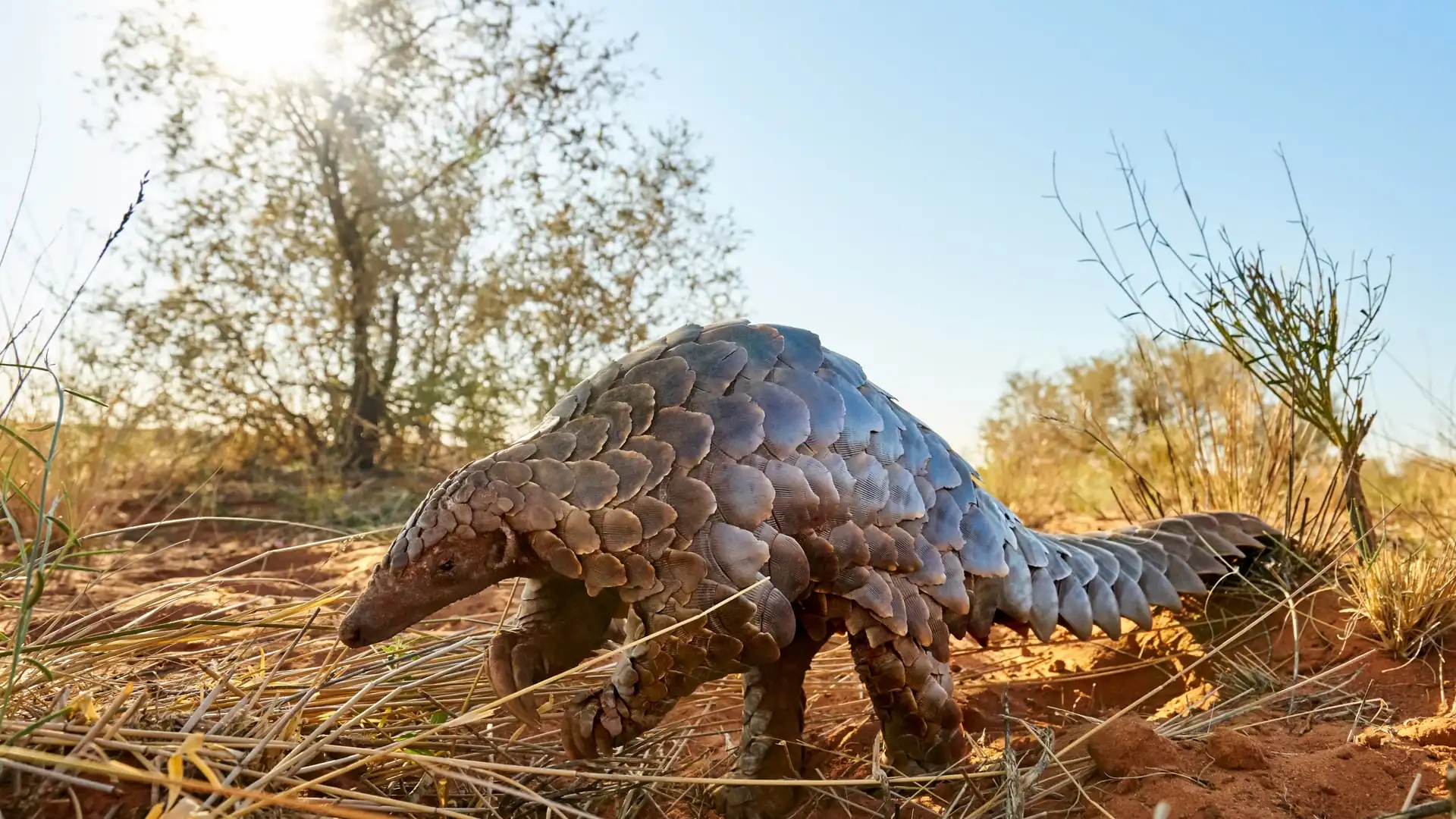
A rare sighting of a pangolin, seen at Tswalu Kalahari in South Africa
Porcupine
The Cape porcupine is the largest rodent in all of Africa, famous for the distinctive black and white quills that form an extraordinary protective body of armor. Strikingly beautiful and needle-sharp, these natural weapons of defense serve to protect the porcupine from potential predators, namely lions and leopards. Contrary to popular belief, the quills are not shot out at said predators. Instead, the porcupine backs up to its victim, leaving the sharp barbs in its wake (in this case, the victim’s flesh). Though they slip in with ease, they are extremely hard to get out due to a cleverly designed backward-facing serrated edge.
The quills that impale a victim’s flesh ultimately cause infections and sores, making it difficult to eat, drink or hunt, causing weakness and fragility. Ultimately, a predator that picks a fight with a porcupine eventually becomes prey as they become increasingly vulnerable to their own enemies.* When not warding away enemies, porcupines are solitary and sweet creatures, highly adaptable and resilient, traveling long distances each night to forage for food. Herbivores by nature, they live off a diet of bulbs and roots of plants, as well as fruit, berries and tree bark.
*It is important to add that the porcupine does issue warning signals in the form of a pungent odor, signaling to its foe to back off. Can’t say they weren’t warned…

A rare sighting of a Cape porcupine on safari in South Africa
Where can I see a pangolin?
Four of the eight species of pangolin are found dispersed throughout Southern, Central and East Africa. These vulnerable mammals like sandy soils and can be found scattered amongst woodlands and savannas that are close to sources of water. Namiri Plains in Tanzania, Tswalu Kalahari in South Africa, and Shinde Camp in Botswana are some top options to take your chances at spotting the elusive pangolin.
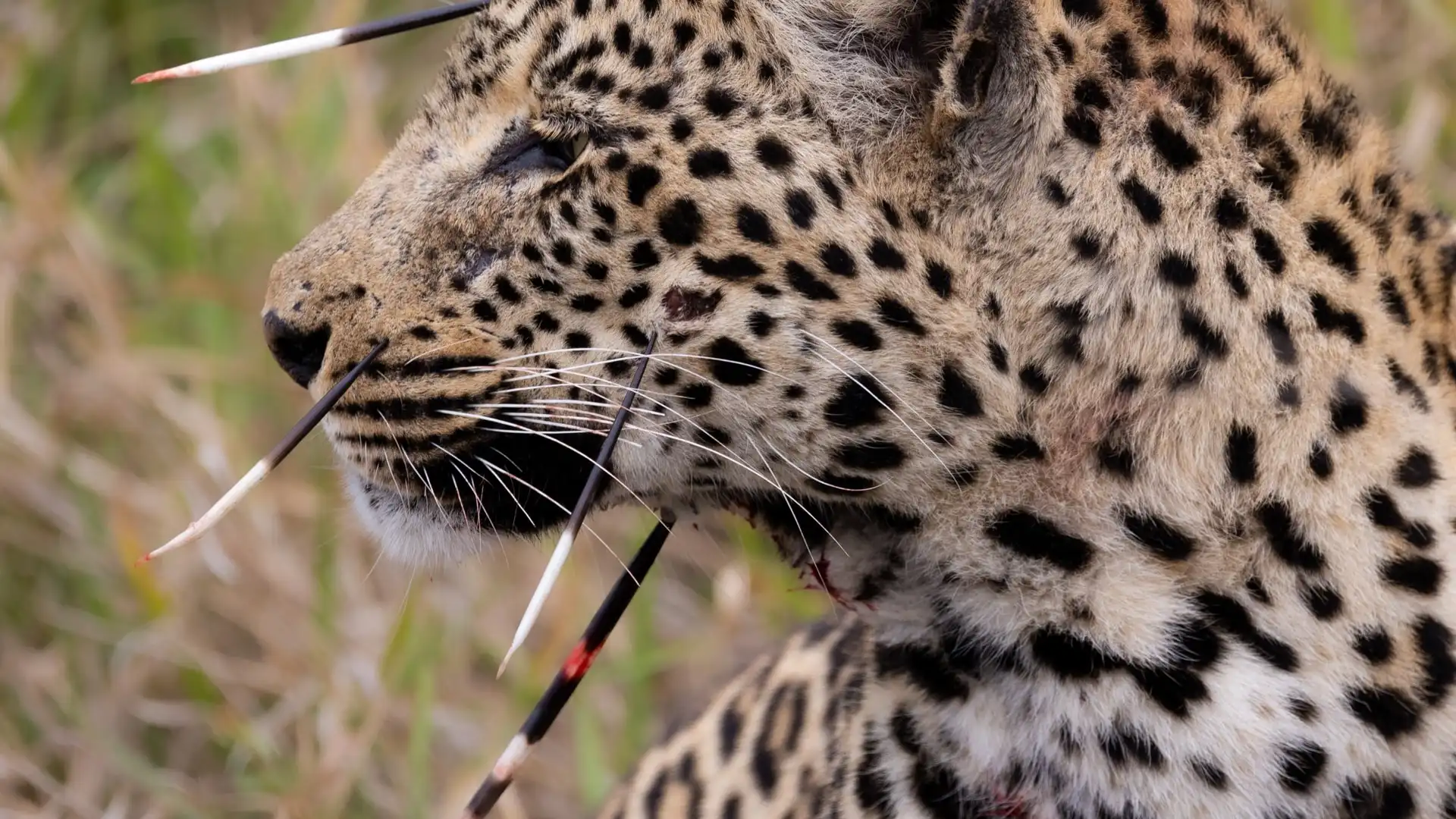
A bloody victim of the porcupine’s spiky wrath
Civet
The African civet is a large viverrid with a distinctive bandit-like mask and striped tail, reminiscent of the North American raccoon. Each individual has a very special set of stripes, blotches and spots, completely unique and particular to that animal. Closely related to small carnivores, including mongooses and weasels, the civet is most well-known for the pungent musk secreted by its glands to mark its territory and attract potential mates. This musk, called Civetone, has been collected by humans for hundreds of years and used in the manufacturing of some of the most popular perfumes in the world including Yves Saint Laurent Kouros, Calvin Klein Obsession and Amouage Gold pour Homme. But don’t let this fool you… The musk, in its concentrated form, is an extremely unpleasant and offensive smell and is only pleasant to humans when it is diluted. It’s no surprise that these scavengers produce such noxious odors when you consider their varied diet which includes poisonous snakes, cyanide millipedes, and other unusual items which they have been found to digest without a care in the world.
Where can I see a civet?
Native to sub-Saharan Africa, the civet is widely distributed throughout Africa. While it is found virtually anywhere in the sub-Saharan region of the continent, it can only be found in the northern parts of South Africa, near the Kruger National Park. The nocturnal nature of these safari animals makes them easier to spot during night game drives.
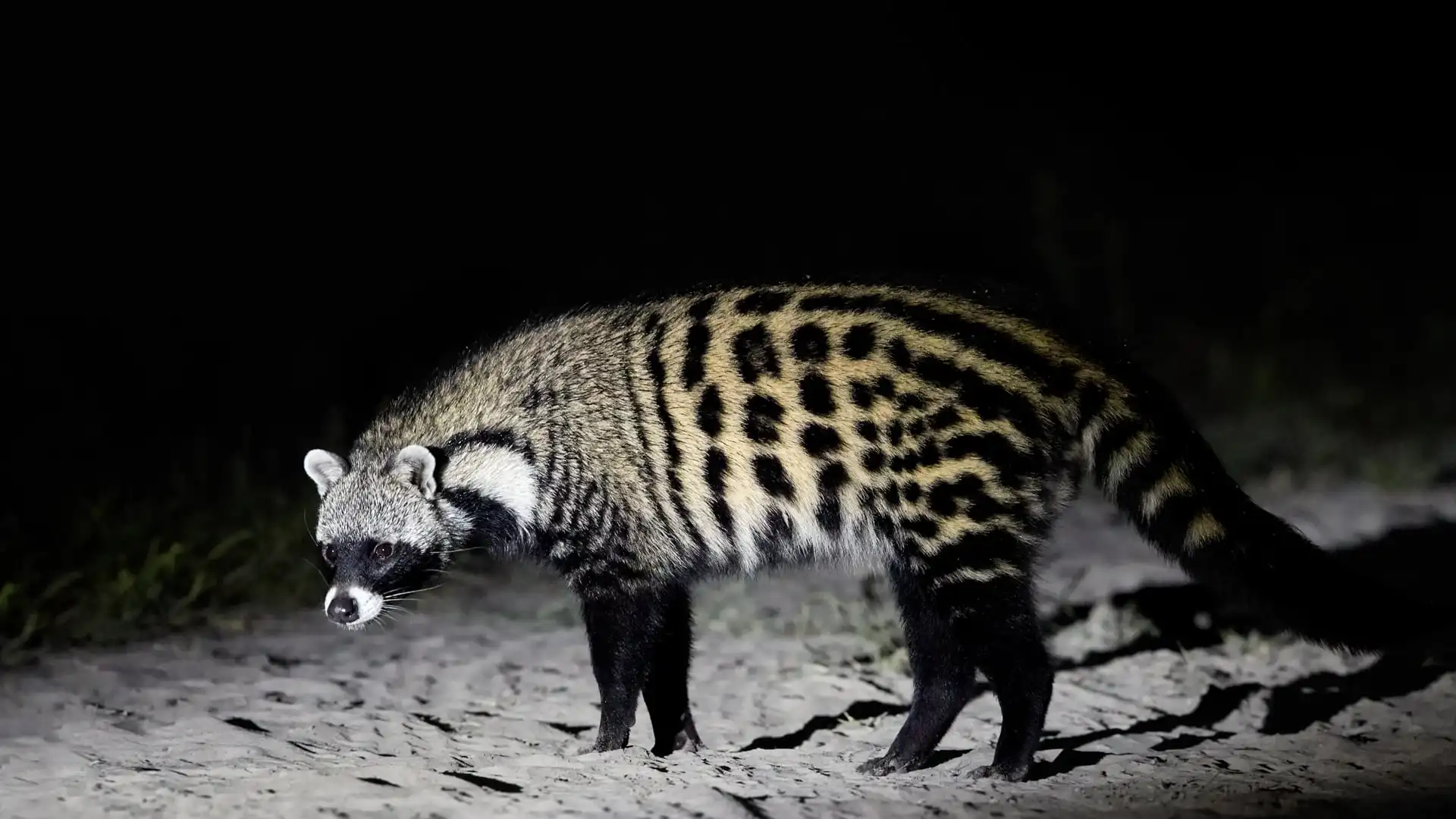
A civet spotted on a night game drive
Serval
The serval is an elegant, slender cat with a beautiful golden-yellow fawn coat and striking black spots and stripes. As is common amongst the secret seven safari animals, the serval spends the daylight hours hiding and resting in the thick bush, before emerging at night to hunt. It has the largest ears of any of the wild cats, relative to its body size, with ultrasonic hearing giving it a huge advantage over its predator peers. Coupled with this, the serval’s long legs and strong slender body make it an extremely stealthy hunter. It can hear just about any peep in the savannah and uses a characteristic stalk-and-pounce technique to catch small mammals, birds and other prey. This deadly ambush is so effective, it is said that up to 60% of pounces are successful, making it the most efficient hunter of all the cats. Their long, powerful legs also serve as excellent springboards, allowing them to jump as high as 12 feet (3.6 meters) in the air to catch unsuspecting birds.
Where can I see a serval?
Serval’s are native to over 35 countries in Africa and are most often found on the savannahs where water is readily available. They especially prefer areas with tall grass and reeds near flowing streams. While sightings of these elusive safari animals are rare, your best chance of spotting them is in the Serengeti National Park in the first hour after sunrise, and just before the sun sets.
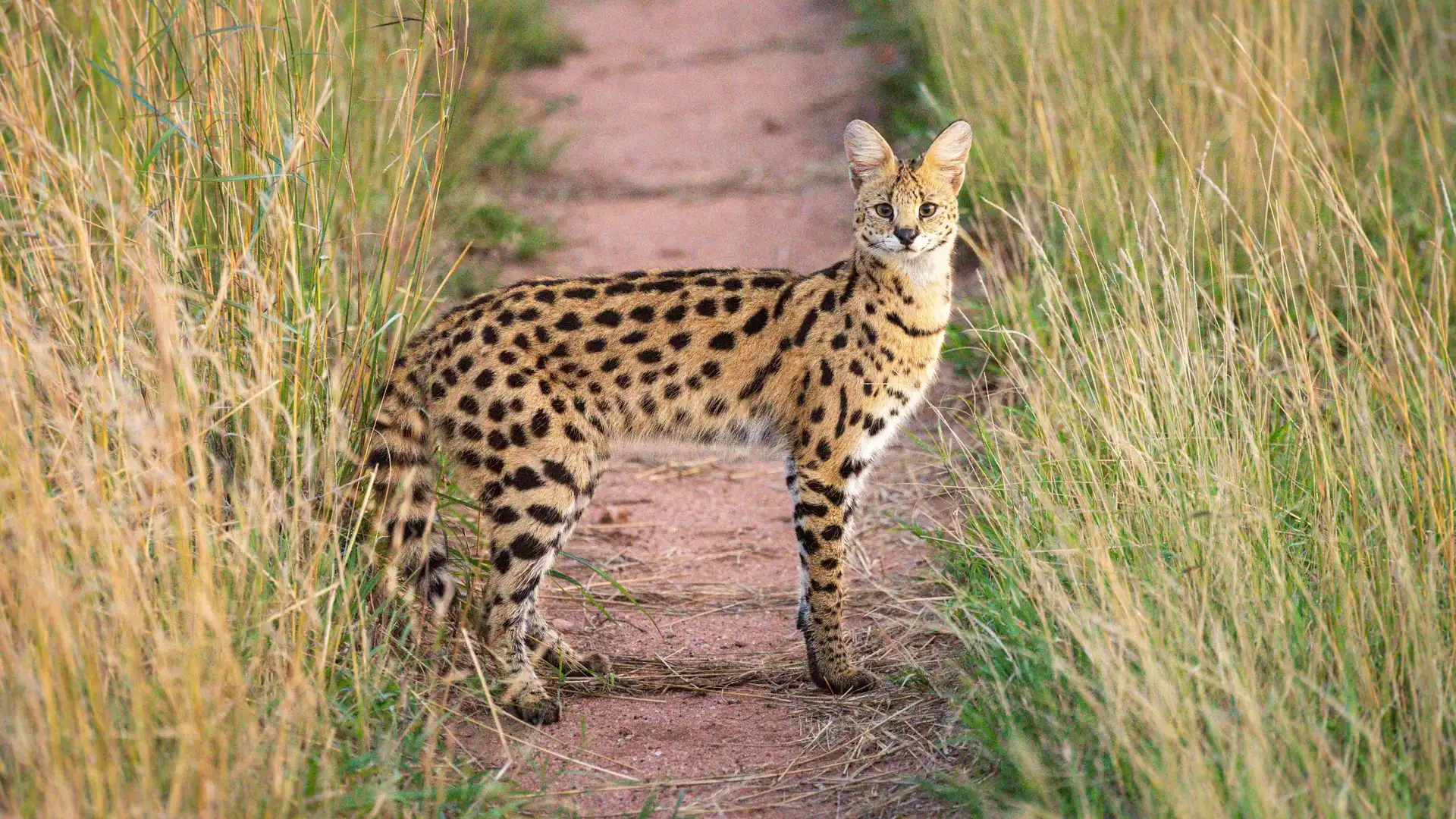
The elegant serval is one of Africa’s most agile and efficient hunters
African Wild Cat
Another solitary and nocturnal member of the secret seven is the African wild cat. Native to Africa, the Middle East and parts of Southern Asia and China, this feral cat is thought to be the ancestor of the domestic cat, first domesticated in Egypt some 10,00 years ago. This very rare species could easily be mistaken for a house cat, but is slightly bigger with much longer legs and a unique gait (similar to that of a cheetah) that distinguishes it from its domestic counterpart. Another distinguishing feature is the African wild cat’s light sandy gray coloring with characteristic rich reddish-brown markings that cover the backs of the ears, as well as tabby-like spots on the tail and back legs. An agile tree climber, and swift on its feet on the ground, the African wild cat feeds mainly on mice, rats, birds and rabbits, and has also been known to take down the occasional baby antelope.
Where can I see an African wild cat?
The adaptability of this beautiful feral cat has allowed it to survive just about everywhere. These striking safari animals are present in all southern and east African countries, as well as some regions in the north and west of the continent. The pure genetic stock of the African wild cat, however, can only be found in extremely remote regions where interbreeding with domestic cats has not taken place.

The solitary African wild cat spotted on safari
Large-spotted Genet
The large-spotted genet is another solitary member of the pack, spending the majority of daylight hours sleeping in old aardvark burrows, hollowed out tree stumps or rabbit holes. Endemic to South Africa, this small, cat-like creature is a member of the mongoose family, characterized by dark spots and stripes on its elongated body. Their bushy tails are usually as long as (or longer than) their bodies with distinctive dark rings and a black tip. Genets emerge from their hiding places after sunset and use their partially retractable claws to catch rodents and insectivores, as well as birds, bats, snakes and even scorpions. These lean omnivores also enjoy eating a variety of fruits. Due to their varied diet and endless supply of insects, fruits and small mammals, the large-spotted genet occurs in stable populations and is a safari animal of ‘least concern’ when it comes to conservation.
Where can I see a large-spotted genet?
Large-spotted genets are found in most areas of Africa. The Ethiopian highlands are their northernmost post and the Cape (in South Africa) their Southernmost. Large populations of these safari animals are found along the southern and eastern regions of South Africa and neighboring countries. They can be seen on night safaris in the Kruger National Park and can sometimes be found in camps scavenging for scraps.
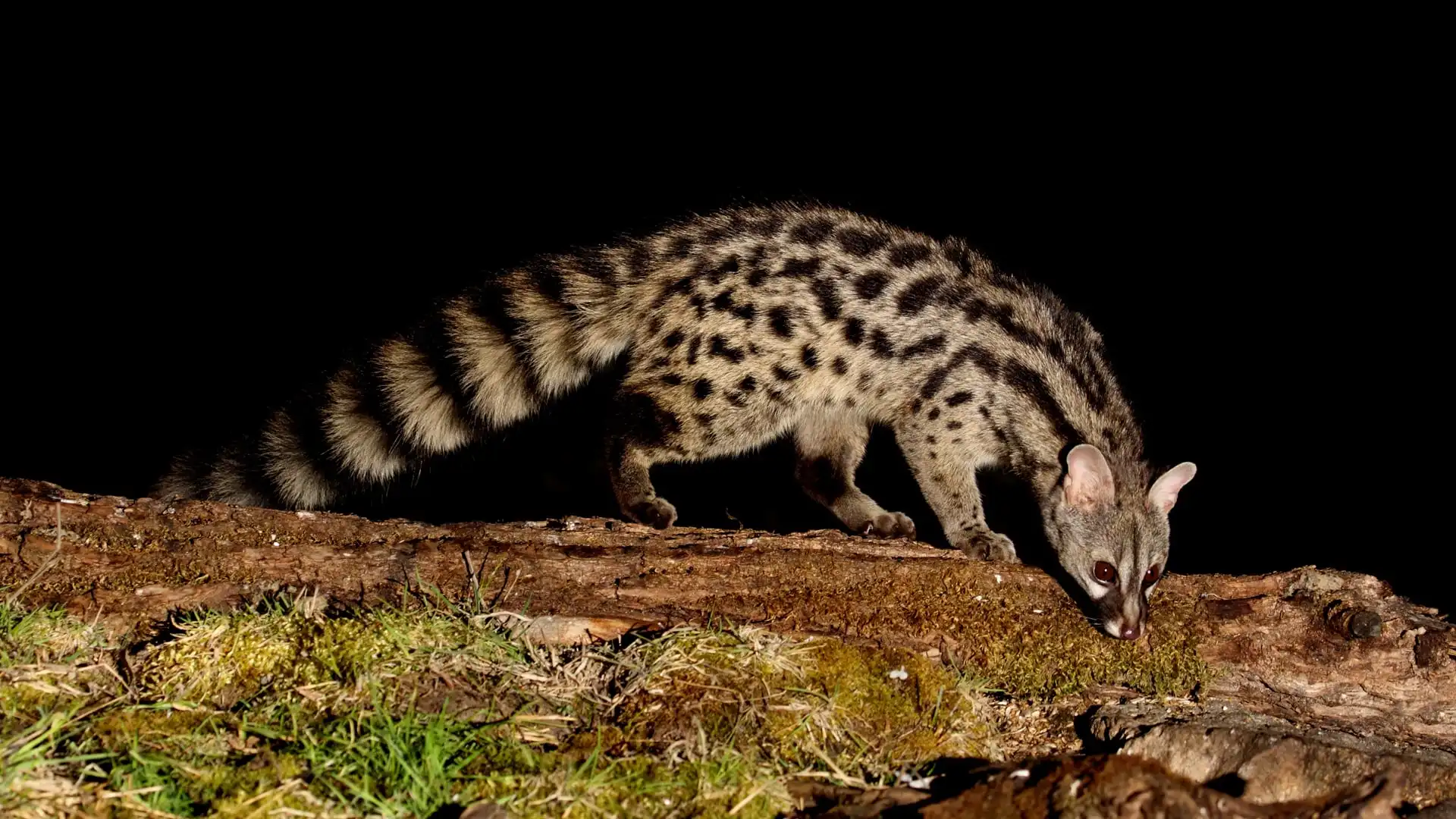
The solitary African wild cat spotted on safari
If one of these extraordinary ‘secret seven’ safari animals is on your bucket list (and patience is your strong point!) get in touch with one of our expert LuxVenture® designers today to start planning an African adventure of a lifetime today!
Curated Packages
Signature journeys across Africa
Our expert team crafts journeys that transcend luxury. Each itinerary is shaped by the spirit of the land and the wisdom of its people — opening doors to experiences few can imagine, and even fewer will ever access.
May-October
|
8 DAYS
Luxury Treehouse Safari to Botswana LuxVenture®
From
per person
All Year Around
|
12 DAYS
Tanzania and Zanzibar Safari
From
per person
Jan, Feb, Jun – Sept
|
5 DAYS
Mountain Gorilla Trekking in Rwanda
From
per person
All Year Round
|
10 DAYS
Botswana & Victoria Falls Adventure
From
per person
All Year Round
|
10 DAYS
Cairo + Luxury Nile Cruise
From
per person
All Year Round
|
9 DAYS
‘Out of Africa’ Safari in Kenya
From
per person
All Year Round
|
17 DAYS
Southern Africa: Framed and Untamed
From
per person
June-October
|
8 DAYS
Tanzania Northern Circuit Safari
From
per person
All Year Round
|
17 DAYS
Luxury Mauritius & South Africa Experience
From
per person
All Year Round
|
14 DAYS
Southern Africa’s Finest: SA, Victoria Falls & Botswana
From
per person
All Year Round
|
13 DAYS
Elephant Safari in South Africa, Victoria Falls & Botswana
From
per person
Jan, Feb, Jun – Sept
|
13 DAYS
Gorilla Trekking, Ngorongoro Crater & Serengeti
From
per person
Year Round
|
11 DAYS
Luxury Seychelles Honeymoon and Couples Vacation
From
per person
All Year Round
|
9 DAYS
Botswana Okavango Honeymoon LuxVenture®
From
per person
June-October
|
9 DAYS
Sub Saharan Kenya Safari Experience
From
per person
May to October
|
8 DAYS
Mad Max Safari Adventure
From
per person
June-October
|
7 DAYS
African Wild Dog Safari
From
per person
June-October
|
10 DAYS
Electric Vehicle Safari in Kenya
From
per person
All Year Round
|
11 DAYS
Luxury Egypt Experience
From
per person
All Year Round
|
11 DAYS
Luxury Safari in Zambia
From
per person
March-December
|
10 DAYS
Luxury Private Safari in Zambia
From
per person
June - Sept
|
11 DAYS
Uganda Done Right
From
per person
All Year Round
|
16 DAYS
Ultimate East Africa Safari
From
per person
Dec – Mar
|
7 DAYS
Wildebeest Calving Season Safari
From
per person
All Year Round
|
7 DAYS
Chobe River Cruise & Okavango Delta Safari
From
per person
All Year Round
|
10 DAYS
Luxury Tanzania Honeymoon LuxVenture®
From
per person
June – October
|
18 DAYS
Tanzania and Seychelles Luxury Safari
From
per person
Year Round
|
15 DAYS
The Ultimate Southern Africa Bush & Beach
From
per person
All Year Round
|
12 DAYS
Tanzania & Zanzibar Honeymoon Safari
From
per person
All Year Round
|
13 DAYS
Amboseli, Lewa and Masai Mara Safari
From
per person
All Year Round
|
11 DAYS
Cape Town Safari & Whale Coast Adventure
From
per person
April-October
|
10 DAYS
Best of Botswana Safari
From
per person
Year Round
|
8 DAYS
African Wild Dog Safari in Zimbabwe
From
per person
15 June - 15 November
|
7 DAYS
Luxury Tented Safari in Tanzania
From
per person
All Year Round
|
6 DAYS
Luxury Morocco Vacation
From
per person
All year round
|
9 DAYS
9-day Victoria Falls to Botswana Luxury Safari
From
per person
Feb – May, Sep – Dec
|
10 DAYS
Luxury Journey Through Morocco
From
per person
All year round
|
12 DAYS
Luxury Family Safari: South Africa & Victoria Falls
From
per person
May-October
|
10 DAYS
South Luangwa Walking Safari
From
per person
June-October
|
9 DAYS
The Great Wildebeest Migration Safari in Tanzania
From
per person
March to June
|
10 DAYS
Zimbabwe Victoria Falls & Safari LuxVenture®
From
per person
June-February
|
13 DAYS
A Cultural Safari Tanzania Zanzibar
From
per person
All Year Round
|
8 DAYS
Best of Egypt LuxVenture®
From
per person
All Year Round
|
9 DAYS
Luxury Safari in Kruger National Park & Cape Town
From
per person
Year Round
|
10 DAYS
Natural East Africa Wonders Safari
From
per person
June-August
|
12 DAYS
Rovos Rail and Zambezi River Escape
From
per person
All Year Round
|
8 DAYS
Luxury Kenya Safari
From
per person
All Year Round
|
7 DAYS
Luxury Gorilla Trekking Safari in Rwanda
From
per person
June - Sept
|
15 DAYS
Gorillas & Big Five Safari Adventure
From
per person
All Year Round
|
14 DAYS
Luxury South Africa and Mozambique Honeymoon
From
per person
All Year Round
|
9 DAYS
Luxury Adventure through Namibia
From
per person
All Year Round
|
10 DAYS
Tanzania & Zanzibar Family Holiday
From
per person
Year Round
|
18 DAYS
Southern Africa Luxury Bush & Beach Escape
From
per person
All Year Round
|
12 DAYS
Stargazing Desert Safari in Namibia
From
per person
All Year Round
|
12 DAYS
Culinary Journey to Morocco
From
per person
All Year Round
|
8 DAYS
Fly-in Luxury Namibia Safari
From
per person
May to October | November to April
|
11 DAYS
Spirit of Zambia Safari
From
per person
All Year Round
|
Day Trip to Antarctica LuxVenture®
From
per person
July-September
|
6 DAYS
Horseback Safari in Kenya
From
per person
All Year Round
|
12 DAYS
South Africa Art, Wine & Wilderness Safari
From
per person
All year round
|
9 DAYS
Beaches of Seychelles Vacation
From
per person